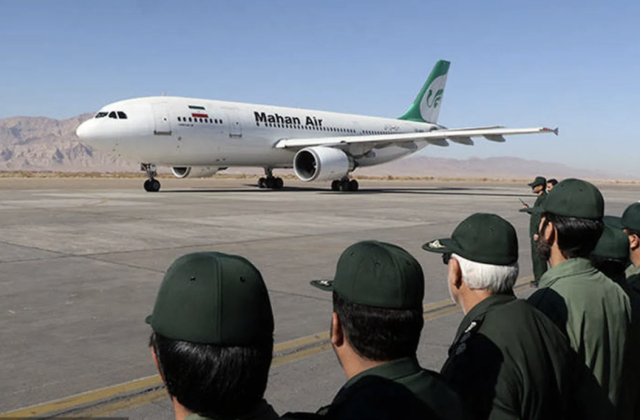Recently Mahan Air has been flying supplies and moving gold from Venezuela to Tehran. Given its past behavior, it is likely that Iranian spies and commandos are also going to Venezuela on Mahan planes.
It is not just the US which looks askance at the airline. Germany, for example, has banned all flights from Mahan Air because of its support for terrorism and for spying. So have Italy and France.
According to the US fact sheet, “Mahan Air has routinely flown fighters and materiel to Syria to prop up the Assad regime. Iran’s military support for Assad has contributed to mass atrocities in the country, the displacement of millions across the region, and exacerbated the greatest movement of refugees and internally displaced persons since WWII.”
Given the above, the fact that two US Air Force F-15 jets out of Jordan intercepted and carried out a “visual inspection” of Mahan Air Flight 1152 as it passed over the US al-Tanf garrison in southern Syria is not a surprise.
What is surprising is that the Iranians were audacious enough to fly over the top of the US al-Tanf base in southern Syria.
What could a “visual inspection” reveal? And why did the Mahan Air pilot put his aircraft into a dive emulating a fighter pilot’s evasive maneuver? A dive which resulted in injury to a number of passengers?
The al-Tanf base houses about 200 US troops and has been kept in Syria, even after the US withdrawal of forces. As former US National Security Advisor John Bolton said, the US presence there was to “counter Iranian influence” in Syria. Around al-Tanf, the US supports the “Revolutionary Commando Army.”
That “army” is composed of about 300 fighters, perhaps less, who were recruited by the CIA allegedly to fight ISIS but more realistically to harass the Assad government and go after Iranian and Hezbollah mercenaries.
Sergey Lavrov, Russia’s Foreign Minister, has called US military presence in Syria generally, and in the area of al-Tanf specifically, “illegal and unacceptable.”
Recently significant strains have developed between Iran and Russia over Syria. The Russians want to consolidate their position in Syria and probably would like to push out foreign fighters supplied by Iran and Hezbollah, not because they are not useful, but because their operations are focused on creating trouble with Israel.
Eye in the Sky
The Mahan Air flight 1152, according to published radar tracks, clearly flew right over al-Tanf as it headed from Tehran to Beirut. The US has established a 55-mile deconfliction zone around the base, which is understood to be a no-go area.
So why would the airliner choose to conduct a flyover? The answer is revealed, to a degree, by the strange maneuver of the jet. The pilot did not want the F-15’s to see something. The F-15’s approached the Mahan jet from behind and rapidly overtook it.
The Mahan flight captain, wanting to avoid a “visual inspection” made a dangerous move so the F-15’s could not see the underbelly of the jet. It is likely the plane was equipped with high-resolution spy cameras that would have been on the underside of the aircraft.
If true, this would suggest that the Iranians are making preparations to attack al-Tanf with missiles just as they carried out similar attacks in Iraq. On January 7, 2020, the Al Assad air base in Iraq came under an Iranian ballistic missile attack in retaliation for the killing of Quds leader Qasem Soleimani.
The attack caused traumatic brain injuries to 110 US troops and caused widespread damage at the base, knocking out helicopters, the base runway, and numerous structures. Because of the concussive blasts from the incoming rockets, even those in shelters became casualties.
An overflight with cameras and sensors would locate key installations that could be targeted by Iranian surrogates, most likely Hezbollah.
There is nothing new about putting cameras and other sensors on commercial aircraft. The Russians used its national airline, Aeroflot, for precisely this purpose. So, when Aerofot commercial flights headed from Moscow via Shannon, Ireland, and flew over New York or on to Washington DC, the Russians had a bird’s eye view of US air bases, submarine and aircraft carrier anchorages, and sensitive defense and government facilities including the NSA.
Similar spy operations were carried out in Europe, highlighting NATO preparations and assessing France’s Force de Frappe and Britain’s nuclear missile submarine fleet.
The Iranian strategy in Iraq and in Syria is to get the US out as quickly as possible by inflicting unacceptable losses on the US side. This would give Iran the freedom of maneuverability they are looking for to consolidate their hold on both countries and use them as a launching pad to attack Israel.
The Iranians also know that US President Donald Trump is personally opposed to deploying US forces in both Iraq and Syria, although the aggressive Iranian-backed attacks in Iraq did not result in a US pullback.
While there are no published reports on what intelligence was available to US forces protecting al-Tanf, the fact that the two F-15s flew from Jordan to intercept Mahan Flight 1152 means they knew where the Mahan Air flight was going well before it got there. That, too, is highly indicative of the anticipated hostile nature of the overflight.


